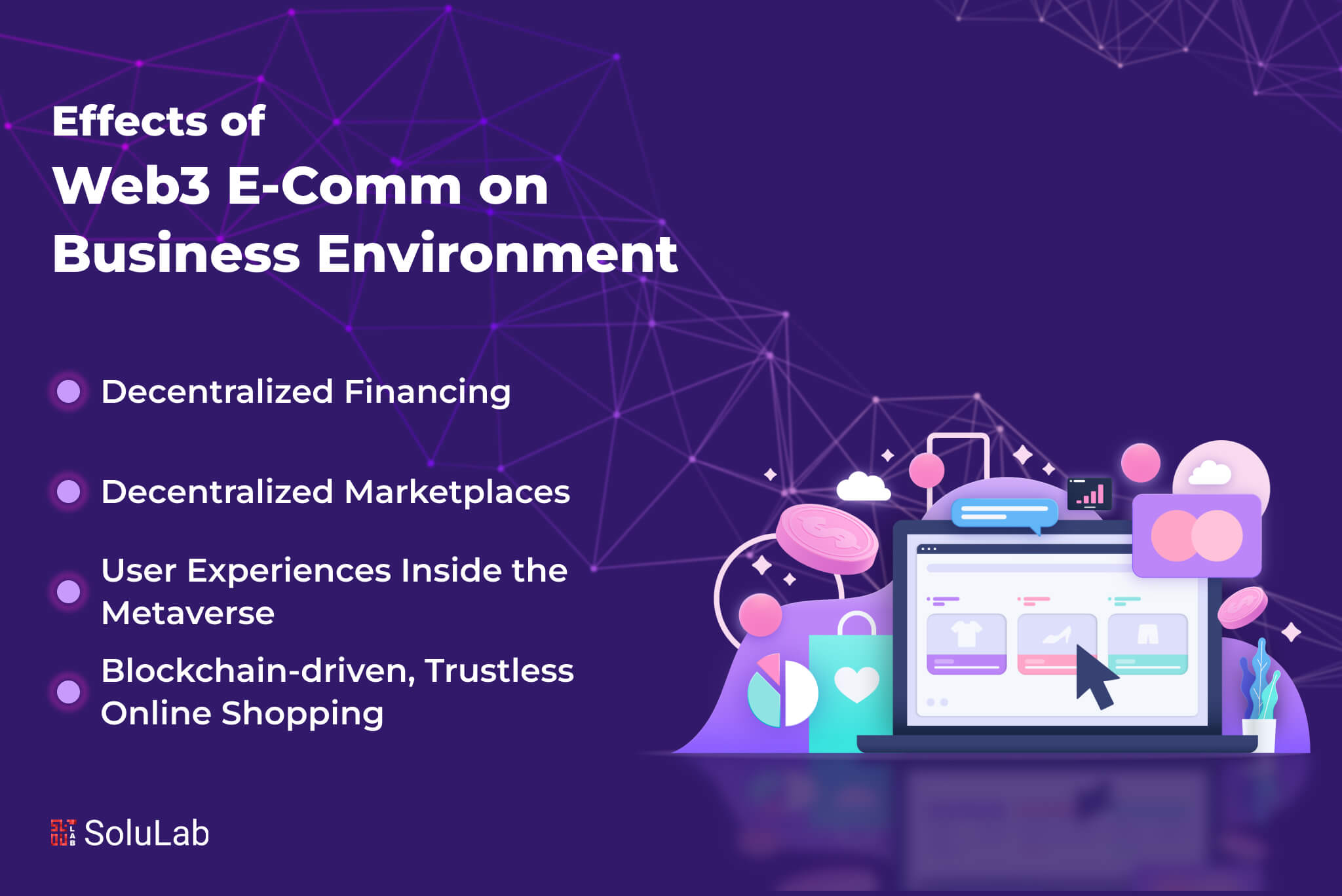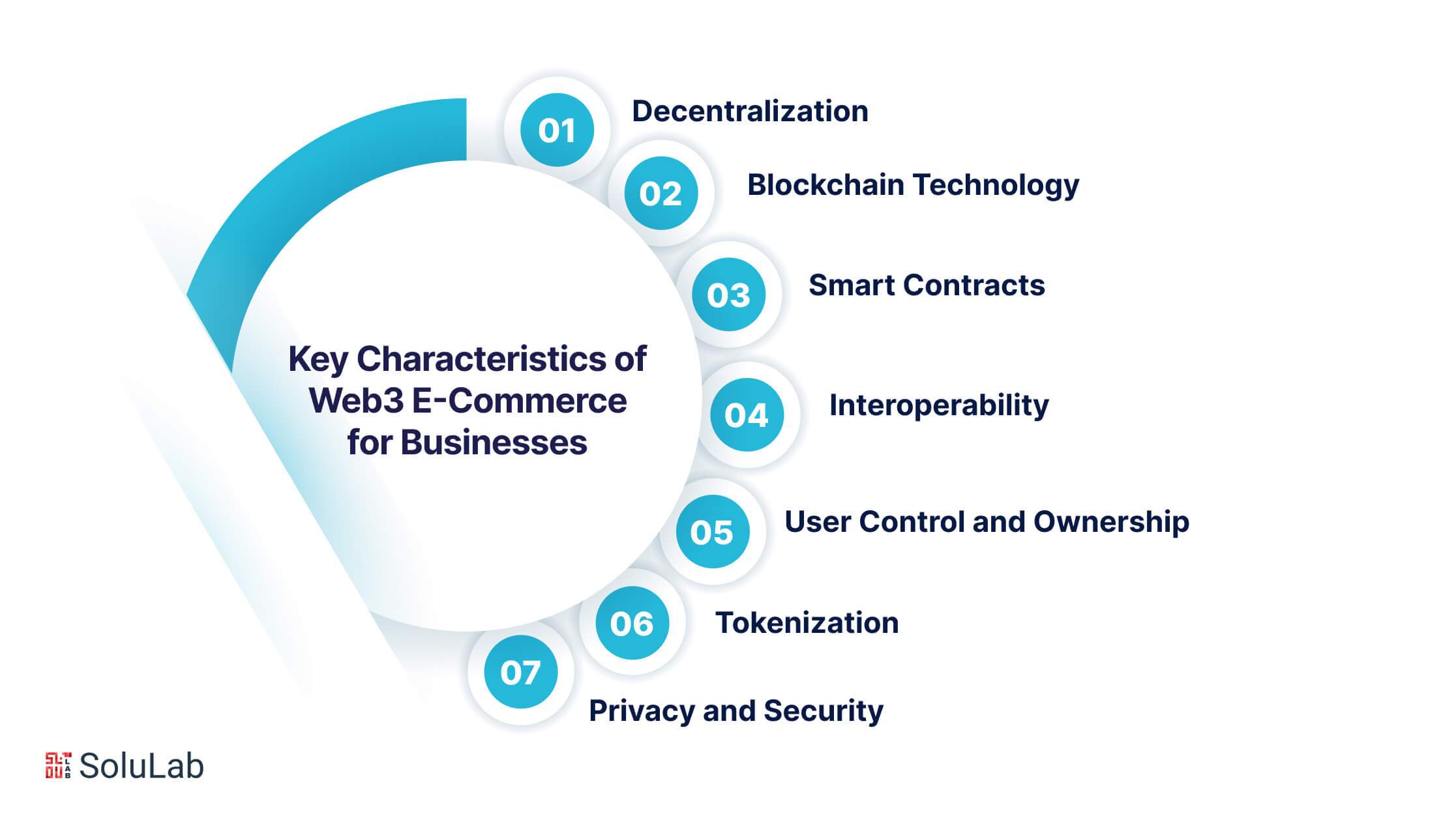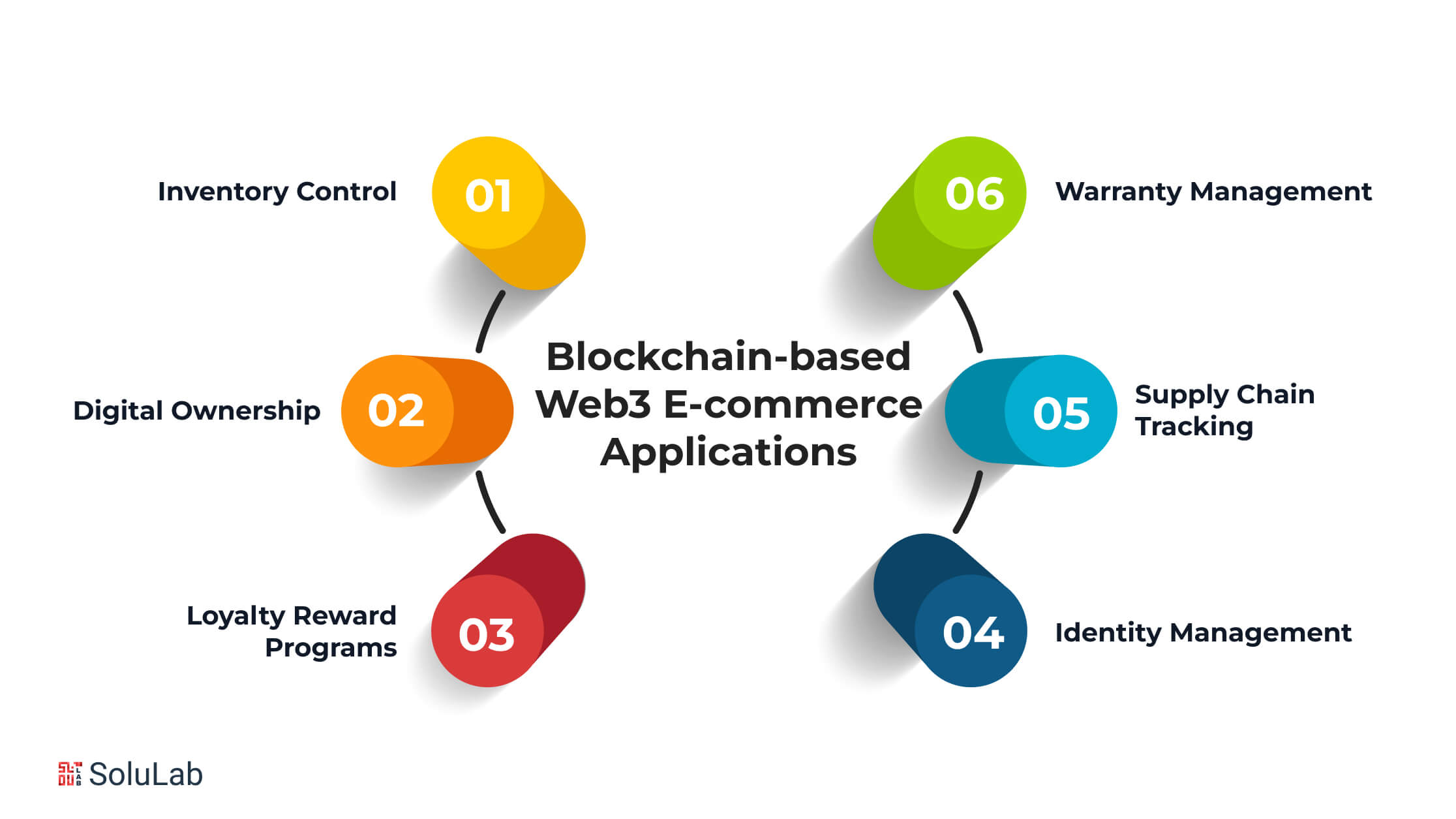
In 2022, sales from e-commerce in the US were $1 trillion, according to Insider Intelligence research. According to a different U.S. Consensus Bureau News analysis, 13% of all retail sales in the first quarter of 2022 came from online sources. These astounding figures demonstrate that, while web3 establishes the foundation for an unsupervised and decentralized internet, we see the beginnings of an e-commerce revolution. We may soon see the emergence of networked, non-exclusive online marketplaces that any brand or seller can use to drive their company. Unlike mammoth platforms that manage sales channels, customer data, and other aspects of their business, Web3 gives companies the freedom to implement e-commerce solutions and systems that best fit their needs.
Despite its enormous success and expansion, e-commerce is not without its drawbacks. The majority of platforms’ reliance on centrally located financial institutions or payment gateways for functions like transactions is the main cause of the issues. Not only is this centralized method of handling financial transactions connected to e-commerce less dependable and secure, but it is also less safe. All necessary data, particularly transactional data, may be directly saved onto a blockchain in a web3-based e-commerce system. The majority of the issues with the present e-commerce system may be resolved by doing this. Web3 e-commerce can therefore be viewed as disruptive, having potentially revolutionary effects on the e-commerce sector.
In this blog, we will delve into what effects Web3 in e-commerce will have on the business environment. So, without any further ado, let’s get started!
What Exactly is Web3?
Let’s take a closer look at the idea of web3, also known as the interactive internet, before delving further into e-commerce inside this future generation of the internet.
Web2, the forerunner of Web3, is owned and managed by a limited number of major businesses due to its consolidated data. One of the co-founders of Ethereum popularized the term “Big Tech,” which is occasionally used to refer to these massive enterprises. This is the exact opposite of what web3 enthusiasts imagine for the digital world. Web3 is a new digital world that improves user experiences via the use of blockchain technology and blockchain ideas like decentralization and token economies. Because Web3 is decentralized, “Big Tech” and other such middlemen are eliminated. This is the allure of Web 3. Users cannot access the internet using centralized platforms like Google, Apple, or Facebook on Web3. With this user-centered online design, everyone may own and manage their own portions of the internet.
Web3 eliminates the need for middlemen or “trust” in order to facilitate virtual transactions, while blockchain technology guarantees the security and dependability of payments. Because Web3 is not controlled by large tech businesses that gather potentially sensitive data, it can also better safeguard user privacy.
Key Characteristics of Web3 E-Commerce for Businesses

Web3 represents a paradigm shift that transcends the traditional confines of the internet. For businesses engaged in e-commerce, the incorporation of Web3 principles is not just a technological upgrade; it’s a strategic move towards a more transparent, efficient, and customer-focused approach. Let’s unravel the key characteristics of Web3 and delve into how they are set to transform the landscape of e-commerce for businesses in the digital age.
1. Decentralization: The hallmark of Web3 is decentralization. Unlike the traditional internet, where power is concentrated in the hands of a few, Web3 envisions a distributed network where no single entity holds control. This move towards a more democratic and inclusive structure is made possible by leveraging blockchain and similar technologies.
2. Blockchain Technology: At the heart of Web3 lies blockchain technology, providing a secure and tamper-resistant foundation. Through decentralized ledgers, transactions are transparently recorded, fostering trust and eliminating the need for intermediaries.
3. Smart Contracts: Smart contracts play a pivotal role in Web3 applications. These self-executing contracts, coded with the terms of agreements, automate and enforce interactions without relying on third parties. This not only streamlines processes but also ensures trustless execution.
4. Interoperability: Web3 is breaking down silos by promoting interoperability. Different blockchain protocols and networks seamlessly communicate, fostering a cohesive ecosystem. This interconnectedness is vital for realizing the full potential of a decentralized web.
5. User Control and Ownership: Empowering users is a key principle of Web3. Individuals have control over their private keys, which serve as gatekeepers to their data and digital assets. Web3 envisions a world where users, not corporations, dictate the terms of their online presence.
6. Tokenization: Tokens, representing ownership or access rights, are a common thread in Web3. From governance to payments, these digital assets play a crucial role in shaping the decentralized economy, providing incentives for active participation.
7. Privacy and Security: In the Web3 e-commerce development, privacy is paramount. Cryptographic techniques are deployed to ensure secure and private transactions, offering users a level of security often lacking in traditional online environments.
Issues Facing the Current E-commerce Sector
Even while e-commerce is becoming more and more popular, it still has certain drawbacks. The following are the main e-commerce obstacles:
- Online Identity Verification: How can a shop ascertain the legitimacy of a customer visiting their online store? Are the details they entered accurate? Do they genuinely have an interest in online goods? Without all of these specifics, how can you move forward? Things can get quite challenging. Nevertheless, by making an investment in online identity verification, this issue may be resolved.
- Data and Cyber Security: Given the volume of information and data involved in e-commerce, security breaches pose one of the biggest concerns. A technical problem pertaining to data might have detrimental effects on the brand’s reputation and day-to-day operations.
- Bringing in the Ideal Clientele: Shoppers have a lot of alternatives these days. Their pre-purchase research is rather costly. How can you be sure that out of all the possibilities they have, they will pick you? How do you locate the ideal client that is willing to purchase your goods at your asking price? In the e-commerce sector, attracting the ideal client is difficult.
- Customer Experience: A good customer experience is a must for a successful e-commerce website. Clients anticipate a comparable experience to what they would receive from a physical business. Therefore, it’s critical to take into account the website’s usability, content flow, product categorization, and retail customization depending on consumer preferences.
- Consumer Loyalty: Two facts demonstrate the significance of consumer loyalty. First, considering the rising expenses of marketing and advertising, obtaining new customers might be more expensive than retaining current ones. Second, selling to an existing client has a better success rate than selling to a potential client. These two statistics highlight the significance of client retention and loyalty. After a client makes a purchase or uses a service offered by a store, loyalty to the business is crucial. They have to make sure this client is with them for the duration of their life.
- Converting Shoppers into Prospective Customers: One of the trickiest e-commerce problems is getting visitors to become paying clients. Even when an e-commerce website receives a lot of traffic, hits, and impressions, the sales results may not match expectations. This is yet another urgent issue facing the e-commerce sector.
- Analysis of Competitors Amid Increased Competition: A “Jam Study” was previously done to gauge the consumers’ level of expertise, and the results were unexpected. The experiment’s findings indicate that the less you have to give clients, the more likely it is that they will buy from you. People are sick of having so many options. Thousands of results may be found with just a quick search for something. So how do you make your decision? Retailers now find it challenging to differentiate themselves from the competition. Additionally, it is now more challenging to persuade customers to visit their website rather than make purchases from other sellers. The main cause of these issues is that the majority of e-commerce platforms depend on banks or payment gateways to do tasks like handling payments. They will have direct access to the blockchain, which will solve the majority of the issues with the present system.
- Customer Service: The number of e-commerce consumers has grown tremendously along with the industry’s fast growth. On the other hand, a growing number of customers encounter different problems virtually daily on different e-commerce platforms. AI-Powered Chatbots have improved customer service by enabling quicker ticket responses and request processing, but these are not long-term fixes. For example, a lot of chatbots irritate and disappoint users.
- Cross-border E-commerce: Due to a lack of engagement with clients from beyond their language and geographic range, many e-commerce websites have a tendency to become stagnant. In order to have a better experience, customers who do not speak the primary language of the website will search for other stores. Prices and tax rates vary between countries, discouraging users from making international purchases.
- Marketing Budgets: For e-commerce companies, digital marketing is starting to become the norm. More businesses are using digital marketing and social media to boost their advertising budgets. Clicks and online advertising space are becoming more expensive. For small and medium-sized e-commerce firms, this may be quite expensive. It is among the most difficult tasks as well.
- Data Privacy: Customers of today understand the value of and necessity for data protection. Apple and other gadget makers are taking all reasonable precautions to keep consumer data safe from outsiders. Still, there are issues with data privacy in the centralized e-commerce market.
Advantages of Web3 E-commerce for Businesses
Web3 and related technologies such as NFTs and cryptos are already having an effect on the e-commerce sector, and this trend is probably going to continue. After all, as companies of all shapes and sizes innovate at a breakneck pace, blockchain technology applications are growing. To demonstrate how this impacts the e-commerce scene, let’s look at some actual cases.
1. Decentralized Financing
With web3, you can buy with cryptocurrency on e-commerce sites like WooCommerce and Shopify.
2. Decentralized Marketplaces
Web3 will provide decentralized marketplaces where consumers will be able to choose what is produced. Users will have total control over the market, which will be run by the community and permit free trade.
3. Blockchain-driven, Trustless Online Shopping
Shortly, customers will probably use distributed, contract-enabled apps known as decentralized apps, or dApps, via the blockchain to purchase goods from online retailers. These will be trustless, immutable transactions carried out by self-executing programs known as smart contracts. Chargebacks, refunds, and fraud will all decline as a result. Even while trust is still the primary force behind e-commerce, web3 will give trust less of a priority since trustless transactions are guaranteed by the blockchain. Cryptocurrency payments for online purchases will become commonplace and function similarly to credit card payments.
4. NFT-driven E-commerce Loyalty Incentive Schemes
NFTs are utilized in e-commerce to make loyalty schemes profitable. Customers who participate in these programs receive points for every purchase, which they may then exchange for goods, deals, or even larger prizes. Businesses are able to provide more valuable loyalty benefits because of NFTs. Businesses may now provide consumers with NFT-based tokens development with a fixed value rather than merely random points.
5. User Experiences Inside the Metaverse
There is no one concept or paradigm for what the metaverse will appear to be like because there are so many new technologies. The metaverse is a synthesis and expansion of several cutting-edge technologies, including blockchain, bitcoin, and AR/VR. The term “metaverse” refers to a network of three-dimensional virtual worlds that are always growing and developing into independent economies. Within the metaverse, e-commerce firms have a unique chance to create memorable consumer experiences as well as an intriguing challenge.
Blockchain-based Web3 E-commerce Applications

Web3’s foundation layer is based on blockchain technology, which makes use of the previously described advantages of web3 e-commerce. Here are some of the Web3 E-Commerce solutions and applications based on blockchain.
- Inventory Control: Retailers may minimize inventory items by using blockchain technology in inventory management. When specific criteria are reached, they can order new goods.
- Digital Ownership: Although a shop owner may spend a lot of money on high-quality images and videos, the e-commerce platform owns the ownership of these materials in addition to other data that is necessary for an online store. Retailers, on the other hand, fully own all digital assets with blockchain, including the digital storefront, product images and videos, and reviews.
- Loyalty Reward Programs: Blockchain enables users to get customized offers and loyalty points. Blockchain technology allows for the safe storage of consumer preference and purchase history data. This enables the blockchain to automate loyalty reward programs and provide customized offers.
- Identity Management: As more individuals do business online, their digital traces become increasingly confusing. Retailers may utilize blockchain technology to build encrypted digital identities and robust consumer authentication systems. By doing this, they would be able to enhance identity management and guard against identity theft and misuse.
- Supply Chain Tracking: Blockchain technology allows e-commerce businesses to keep tabs on the supply chain. It enables them to make sure suppliers follow the established standards and don’t replace items without warning. The procedure is conducted with transparency.
- Warranty Management: Retailers can quickly and easily store warranty information using blockchain technology. The data will be accessible to merchants, producers, and customers alike. This makes it possible to quickly obtain, validate, and verify warranty information.
What Steps Should Businesses Take to Get Ready for Web3 E-Commerce?
Brands are getting ready for the seismic shift of Web3, which has the potential to completely change e-commerce, as the digital environment continues to change. The strategic vision is necessary to prepare for the evolving landscape of this decentralized era. We’ll look at feasible steps that companies may take in this section to seize the lead in Web3 e-commerce by utilizing blockchain, NFTs, and the metaverse.
1. Token Gated Commerce: Embracing blockchain and NFTs is a critical step in Web3 e-commerce. Introducing token-gated commerce establishes a direct link between these technologies and your brand’s offerings, providing customers with a compelling reason to invest in your NFTs and fostering heightened loyalty.
2. Metaverse Experience: Just as personalized retail experiences have shaped traditional e-commerce, the metaverse introduces a new frontier. Brands can create immersive metaverse experiences, allowing customers to preview products with customizable features that sync seamlessly with their avatars. This not only enhances interaction but also draws customers to your Web3 presence.
3. Gamify Your Shopping Experience: In the Web3 era, engaging a younger audience involves infusing an element of play. By gamifying the shopping experience, brands can tap into the rising trend of NFTs to unlock exclusive parts of the customer journey. This interactive approach generates excitement and buzz, setting your brand apart from traditional advertising methods.
4. Accept Cryptocurrency Payments: Embracing cryptocurrency payments isn’t just a nod to technological trends; it’s a strategic move with statistical advantages. Among crypto enthusiasts, accepting crypto payments has been shown to create larger order values. Moreover, it builds trust with customers who appreciate the forward-thinking approach to finance in the Web3 landscape.
The Future of Web3 in E-Commerce Industry
The future of e-commerce is undergoing a profound shift with the advent of Web3. This transformative technology is set to revolutionize the way products are sold online. Let’s delve into the implications and explore how Web3 e-commerce solutions will redefine the digital selling landscape.
- Token Gating for Retail: Because of NFTs and dApps, customers often believe they are an integral component of a decentralized brand. According to Forbes, “You may begin developing brand loyalty there because the worth of an NFT isn’t just in the asset, it’s also in what the buyer gets from the asset.” By providing devoted consumers with digital ownership via customer avatars and token-gated trade, future shops will be able to prosper.
- Increased Investment in Web3’s Direct-to-Customer (DTC) Model: It will enable decentralization for businesses that are able to cultivate one-on-one connections with their clients. An increasing number of e-commerce companies have come to understand that utilizing the DTC model may help them establish direct connections with consumers, hence extending their longevity in the market.
- Omnichannel Marketing: Consumers like interacting with companies across a variety of channels when they use omnichannel marketing. According to a study by Omnisend, omnichannel marketing boosts client retention with 90% greater retention rates than single-channel marketing. Customers may find omnichannel marketing distinctive due to Web3’s customization. Artificial intelligence (AI)-powered consumer avatars will provide them with more customization. Additionally, Web3 will allow for larger-scale, higher-quality customization, which may eventually result in improved retention rates since customers tend to choose “knowledgeable” companies.
- Acquisition of Customers: Internet access is unrestricted by gatekeepers for marketers. Even better, customers will extend an invitation to advertisements. Web3 will evolve into something more collaborative and less like advertising. Within the web3 ecosystem, newer channels that were less common in web2—like streaming music or in-game advertising—will serve as points of acquisition for prospective clients.
- B2B Payments: B2B and B2C e-commerce are starting to resemble each other more. For instance, Shopify Plus enables you to combine more conventional B2C capabilities, like customizing shopping experiences, with B2B tactics, like unique pricing choices. Web3 E-commerce services are democratizing consumer-brand interactions. We anticipate that in the future, the distinctions between B2B and B2C purchases will become increasingly hazy.
Conclusion
In conclusion, Web3 is the decentralized rendition of the Internet that aims to fix the issues with older versions of the Internet, such as web1 and web2. Expect new e-commerce standards with more alternatives for customers as AR and VR gain traction as experience-enhancing technologies and NFTs continue to soar. Contemporary companies want to support their clientele wherever they shop—online, in-person, or on social media. Web3’s connection makes omnichannel strategies even more effective as it allows firms to integrate all of their sales channels and operational systems, giving customers a smooth e-commerce experience. Because Web3 is inherently decentralized, marketers can make use of blockchain’s extensive technological stack and run their apps without a single point of failure.
For businesses looking to harness the power of Web3 and stay ahead of the curve, SoluLab stands as a beacon in the realm of Web3 development. As a leading Web3 development company, SoluLab offers comprehensive solutions to navigate this new frontier. Whether it’s integrating blockchain for transparent transactions, developing decentralized applications, or creating engaging metaverse experiences, SoluLab’s team of experienced and skilled developers is at the forefront of Web3 innovation. For those ready to embark on their Web3 journey, it’s time to take the next step. Hire Web3 developers from SoluLab and unlock the full potential of this transformative technology for your business.
FAQs
1. What is the significance of Web3 in the e-commerce industry?
Web3 introduces a decentralized paradigm to the e-commerce landscape, revolutionizing how transactions are conducted online. It prioritizes transparency, security, and user control, fundamentally changing the way businesses engage with customers and conduct digital commerce.
2. How can Web3 e-commerce development benefit my business?
Web3 e-commerce development brings numerous benefits, including enhanced security through blockchain technology, transparent transactions with smart contracts, and innovative solutions like tokenized loyalty programs. It empowers businesses to stay ahead of the curve, offering a more user-centric and efficient online selling experience.
3. What services do Web3 e-commerce development companies offer?
Web3 e-commerce development companies provide a range of services, including blockchain integration, smart contract development, decentralized application (DApp) creation, and metaverse experiences. These services aim to help businesses leverage the full potential of Web3 technologies for their e-commerce operations.
4. How can my business implement Web3 e-commerce solutions?
Implementing Web3 e-commerce solutions involves partnering with a reputable Web3 development company. They will assess your business needs, integrate blockchain technologies, and create customized solutions to align with your e-commerce objectives. This strategic approach ensures a seamless transition to the Web3 era.
5. Why should I consider hiring Web3 developers for my e-commerce business?
Hiring Web3 developers is crucial for staying competitive in the evolving e-commerce landscape. These professionals specialize in implementing cutting-edge Web3 technologies, ensuring that your business remains at the forefront of innovation, benefiting from decentralized solutions, and offering customers a more secure and transparent online experience.
6. How can SoluLab assist my business in adopting Web3 e-commerce solutions?
SoluLab, as a leading Web3 development company, provides comprehensive services to facilitate the seamless adoption of Web3 e-commerce solutions. Their expert team of Web3 developers specializes in blockchain integration, smart contract development, decentralized application (DApp) creation, and metaverse experiences. By partnering with SoluLab, your business can harness the transformative power of Web3 technologies, ensuring a secure, transparent, and innovative e-commerce environment. To explore the possibilities and unlock the full potential of Web3, consider hiring SoluLab’s skilled Web3 developers for a strategic and efficient implementation tailored to your business needs.






